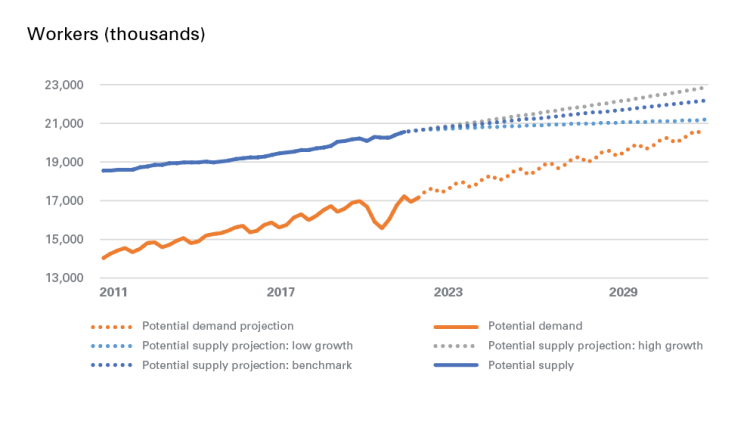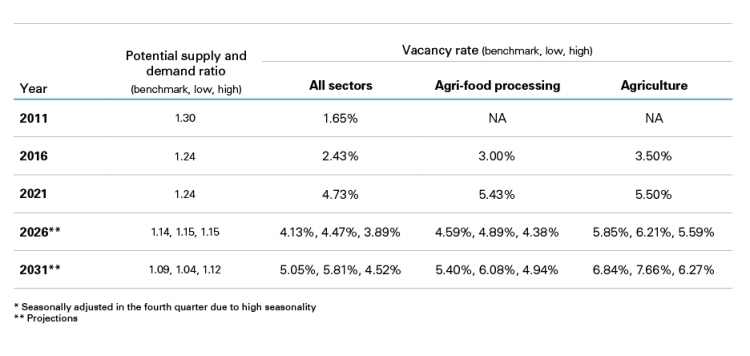Is the labour shortage here to stay?

The labour shortage has been front-page news for some time now. Access to labour is a major concern in agriculture and agri-food processing. The shortage of workers has developed because of low growth in labour supply compared with demand. Retiring baby boomers and low population growth are the main reasons for the slow growth in labour supply. Is the labour shortage here to stay? Could it worsen if the current trends continue?
Current labour supply and demand trends
Potential supply is defined here as the active population, while potential demand is the total number of jobs occupied and vacant. We talk about potential supply and demand because we ignore wages determined at the point where the supply and demand curves intersect.
Figure 1 shows that the gap between potential supply and potential demand has grown increasingly narrow since 2011. This situation has created an increasingly tight labour market. Figure 1 also shows projections for potential labour supply and demand. Labour supply scenarios have been taken from a Statistics Canada study conducted in 2019. We have produced potential labour demand projections by taking economic growth and assuming that COVID-19 has not had a structural effect on the labour market. Regardless of the scenario considered in terms of potential supply, we can see that the gap will continue to shrink.
Figure 1: Changes in potential labour supply and demand in Canada

Sources: Statistics Canada and FCC calculations
Consequences of the anticipated shortage
To quantify the extent of the future labour shortage, we can use the inverse relationship between the ratio of potential supply to potential demand (hereafter, “the ratio”) and the vacancy rate. The ratio measures the relative labour shortage, whereas the vacancy rate quantifies the impact of the labour shortage on employers. When the ratio decreases, the vacancy rate tends to increase. The ratio applies to all sectors but impacts vacancy rates differently across sectors due partly to working conditions specific to each sector and their geographical distribution.
Table 1 shows that we can expect an increase in the vacancy rate for all labour supply growth scenarios. Projections shown in Table 1 suggest that the vacancy rate may decrease from 2021 to 2026. This projection is made on the assumption that the impact of COVID-19 on the labour market is temporary and will gradually disappear by 2026. If the impact of COVID-19 is not transitory, our projections underestimate the vacancy rate. In any case, Canadian businesses of all sectors will be grappling with a growing labour shortage. If the long-term trend continues, the vacancy rate could be above 5% in agri-food processing and close to 7% in agriculture by 2031.
Table 1: Vacancy rates according to the ratio of potential supply and demand

Sources: Statistics Canada and FCC calculations
Regional discrepancies and potential solutions
The above data are for Canada and don’t capture regional differences. According to the latest data, vacancy rates in Quebec and British Columbia stand at approximately 6%, whereas they are below 4.5% in the Prairie provinces. We can’t say whether these regional differences will increase or decrease, but in our analysis, we expect to see vacancy rates increase across the country.
What are the solutions to the labour shortage issues?
Slow down of labour demand growth through automation and expansion to better leverage economies of scale. With the recent interest rate hikes, however, businesses will be less inclined to make investments that won’t pay off for many years.
Increase labour supply growth through immigration policies that make it easier to bring in temporary or permanent workers. In the agricultural sector in particular, the inflow of temporary foreign workers coming to Canada under the Temporary Foreign Worker Program will grow over the coming years due to the high demand. Bringing in temporary foreign workers is costly for businesses, however.
The proposed solutions will have an impact over the long term, and implementation cannot be delayed too long otherwise, the labour shortage will worsen and become a barrier to growth. Given the current situation and the above projections, both short- and long-term, businesses will need to set themselves apart and get creative to attract workers by offering advantageous working conditions, including competitive wages and benefits.
Article by: Antoine Duchaîne, Intern economist